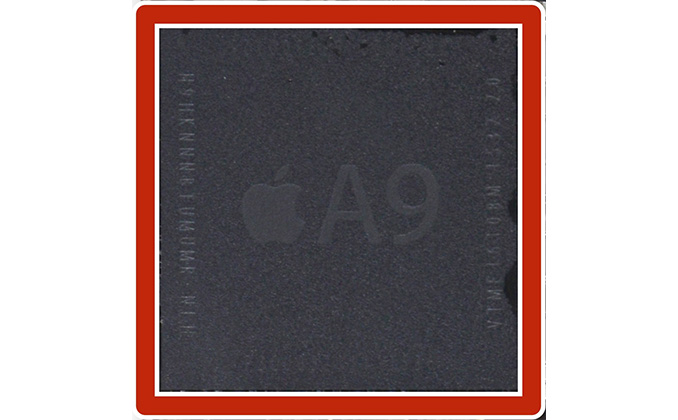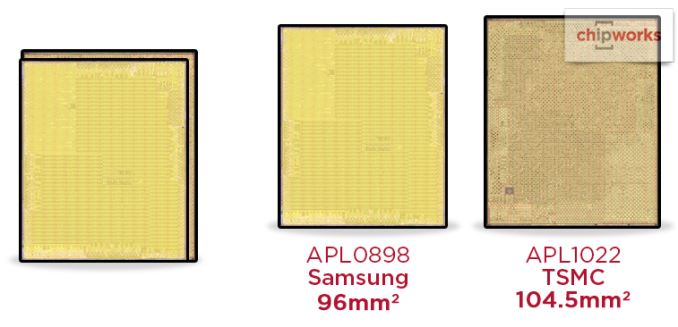Apple’s A9 SoC Is Dual Sourced From Samsung & TSMC
by Ryan Smith on September 28, 2015 7:00 PM EST
Picking up from our conversation this morning on Apple’s A9 SoC, the crew over at Chipworks has been working hard over the weekend to decap A9 and their first results are in. As it turns out, Chipworks has found chips fabbed by both TSMC and Samsung, which means that A9 is in fact a dual sourced part.
In taking apart iPhones and decapping SoCs, Chipworks has turned up two SoCs. The first, APL0898, is a 96mm2 A9 that’s fabbed by Samsung. The second SoC, APL1022, is a 104.5mm2 SoC fabbed by TSMC. And while Chipworks isn’t naming the specific manufacturing processes used, based on Apple’s comments on a “new transistor architecture,” we’re certainly looking at a form of FinFET. In which case the two chips are made on versions of Samsung’s 14nm FinFET and TSMC’s 16nm FinFET processes respectively.
This development is interesting for a few different reasons. From a fabrication standpoint, Samsung and TSMC have been brawling at multiple levels (technical and legal) to be the first to get a next-generation FinFET process out the door, with Samsung ultimately winning that battle when they shipped the 14nm Exynos 7420 for the Galaxy S6 family. For TSMC on the other hand this is as far as we know the first consumer product released with a 16nm TSMC fabbed part, indicating that TSMC is finally able to ship such parts in a reasonable volume.
More importantly, this is a huge move for Apple, and one we admittedly don’t have all of the facts about at this time. Dual sourcing parts is by no means a new concept – IBM requiring a second source of x86 chips is how AMD got started in the x86 industry, after all – but in more modern times dual sourcing of high performance parts is very rare due to how difficult and expensive it is. With dual sourcing essentially requiring the chip to be taped out twice – once for each fab – it requires significant financial and engineering resources, a cost that not very many companies besides Apple can take on without significant risk.
| Apple A9 SoC Versions | ||||
| APL0898 | APL1022 | |||
| Manufacturing Process | Samsung 14nm FinFET | TSMC 16nm FinFET | ||
| Die Size | 96mm2 | 104.5mm2 | ||
The big hurdle with dual sourcing a part such as a cutting-edge SoC like A9 is that unless the source fabs have designed their processes to be near identical – to form a common foundry specification – then different fabs will have different processes with different characteristics. This in turn is determined by the technical decisions a fab made in research and development, and the specific issues the fab ran into when bringing up the new process. The end result being that while two fabs can turn out chips based around the same design, those chips will not be identical. It’s this kind of inconsistency that chip customers like Apple have to tackle head-on if they want to go with dual sourcing.
Even at a physical level we can see this inconsistency right away in terms of die sizes. Despite the TSMC and Samsung processes being quite similar, the Samsung A9 is the smaller of the two by 8%, which as Chipworks notes is indicative of better density on Samsung’s 14nm node. What we don’t see, and the issue Apple really has to control for, is power consumption. Right now it’s a safe assumption that both chips can reach Apple’s required clockspeeds, so in order for Apple to utilize both in the iPhone 6s they need to make sure both perform as identically as possible, especially when it comes to idle power leakage and power consumption at different clockspeeds. The billion dollar question right now is whether either of the A9s is consistently better than the other one, and in which case by how much. For Apple it’s best that these chips are identical as possible – and they can make design choices when taping out the chip for each fab to help ensure this – but at the end of the day even Apple has to bow down to the laws of physics.
But the biggest unknown right now is why Apple would do this given the difficulties involved; to develop two A9s at twice the price. We can certainly speculate on reasons they would do this – yield issues at a fab, a desire to avoid putting all of their eggs in one basket and giving one fab too much power, or even just wanting to ramp up A9 production quickly by doubling the number of fabs working on it. But at the end of the day I don’t expect that’s a secret that will be known beyond the halls of One Infinite Loop, so speculation is all we have to work with for now.
In any case, if Apple has done their homework then dual sourcing A9s shouldn’t have an impact on average consumers, beyond perhaps ensuring that Apple has a sufficient supply to meet demand (ed: Apple sold 13mil iPhones in their opening weekend). Otherwise for techies, things are both more interesting and frustrating; just dual sourcing A9 makes an interesting product since this is something we almost never see done these days. As for the billion dollar question of which A9 is better, that will be a tossup. With enough time, effort, and a very large number of iPhones, it should be possible to coarsely determine if the A9s significantly differ in battery life, and thereby power consumption. However given the difficulties in taking an iPhone apart to access the A9, one would really need a software identification method to really make use of this information.
Source: Chipworks (A9 Shot Courtesy iFixit)












99 Comments
View All Comments
astroboy888 - Tuesday, September 29, 2015 - link
So is Samsung 14nm, using 20nm metal. Intel 14nm which is using 22nm metal.tipoo - Tuesday, September 29, 2015 - link
No, Intel uses 14nm for both FEOL and BEOL, unlike others.dontlistentome - Tuesday, September 29, 2015 - link
Everyone is missing the most interesting thing here.This die is ~100mm2 on the same size process as intel uses for Broadwell. The Broadwell Core M is ~82mm2 - ie, the iphone CPU is 25% larger than that in the Macbook.
Given the benchmarks are getting uncomfortably close for Intel, expect future Intel cpus to start fattening up with bigger cores and (finally) decent jumps in IPC. About time too - their cores have been shrinking in physical size at the same time as they've been upping the prices...
Qwertilot - Tuesday, September 29, 2015 - link
Probably all sorts of stuff in the A9 that isn't in the CoreM mind :)tipoo - Tuesday, September 29, 2015 - link
It's not on the same sized process, despite the advertising.http://www.extremetech.com/wp-content/uploads/2014...
name99 - Tuesday, September 29, 2015 - link
The CPU is comparable to Broadwell Core-M.The GPU is already twice Broadwell Core-M performance.
And of course there's a bunch of stuff on die, from h.265 encoders/decoders, TrustZone support, secure storage, and ISP, that all aren't present on Intel.
lilmoe - Tuesday, September 29, 2015 - link
The sad story here is that even with their well known shortcomings, they have absolutely no incentive to improve other than pushing their "newer" silicon. IE: the biggest competitor for Intel is Intel. Why? x86. If you want to build an x86 device, your ONLY competitive options are either CoreM or Atom.Zen is the only thing that might change that either by being better, or by forcing Intel to change their ways. If Zen's a flop, forget ARM-like progress in the x86 market.
Either way, Intel has an obligation to be more dedicated in offering better value for their users (and OEMs). They need to scrap Airmont (and its successors) altogether and stick with an improved Core M series of chips with both dual and quad core models. One that is competitive in price with tablet ARM processors. Their GPU performance on Core M is nothing short of embarrassing. It needs to be twice the performance at least. I'd prefer if it was closer to Tegra X1 in performance.
The Atom brand is already a turn-off for consumers and reviewers (whether being rightfully so or not). They should start fresh with the Core M branding. If they're insisting on using Atom, throw that to their smartphone segment.
iwod - Tuesday, September 29, 2015 - link
I dont have actual numbers to back me up, so rough estimate or educated guess.Intel currently ships about 300M CPU per year. That includes everything from Desktop, Mobile, and Server. And I would guess majority, or Half of those are Haswell / 22nm.
So on a rough estimate we are talking about 150M 14nm CPU from Intel. Apple is on its way to sell roughly ~200M iPhone this year, if we account for iPad Pro A9X, we are talking about Apple shipping more CPU on the most advanced node then Intel!
I am not quite sure has there been anything like this in history, shipping massive amount of SoC on the most advance node to 200 millions of customer in a year!
And remember Intel has never even rolled out a leading node chips which this amount of quantity!. Apple sold 13M of those in 3 days, and history tell us Apple will sell most 2Q within its product launch. It is no wonder why Apple hedge its bet with dual source Fab.
StrangerGuy - Tuesday, September 29, 2015 - link
There isn't a shadow of doubt that the A9 will outship the entire Intel chip volume this holiday quarter. PC sales are falling and 14nm yields are bad as seen by the poor supply of 6700K.And it's kinda crazy to think about it: The world's largest semicon company outshipped in volume by a consumer electronics firm producing their own phones with their in-house designed high performance SoC and SSD solution.
Wolfpup - Tuesday, September 29, 2015 - link
PC sales aren't falling. Where did you get that idea?